Scott Sambucci is the Founder & CEO at SalesQualia, a sales coaching company that helps B2B Startups to grow sales faster. He is a sales coach, author and keynote speaker.
He’s formerly the Head of Sales at Blend. He has extensive experience in sales, customer development, and company management in both startups and public-traded companies. You can download a free copy of his most recent book – “Stop Hustling, Start Scaling” on his website.
The first thing to ask SaaS founders is why did you start your company and they usually begin with a story about a problem they saw in the marketplace and how they came up with an idea to solve the problem.
You typically start with an idea and you want to get to the level where you are making an impact and the journey typically looks like this, it starts off slow, takes a long time and you start to pick up speed as you start to grow.
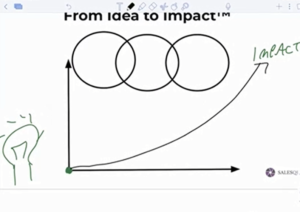
Every startup goes through three distinct phases.
The first phase is called the startup phase. In this phase you are going from idea to minimum viable product, going through your product launch and finding your initial customers.
The second phase which is the intermediate stage is called the ramp up phase. In this stage you are growing past your initial customers and you are trying to ramp up sales and your company’s growth.
The third phase is called the scale up phase. This is the phase we read about in TechCrunch, it is the fun phase where SaaS founders want to be at. This is where you have built your product, gotten some customers and investors are telling you that you have to figure out how to scale your company.
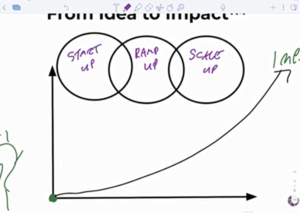
It is important to have clear goal so that you can identify what you need to achieve in order to transition between the various phases.
StartUp phase
For SaaS startups serving B2B clients, it is important to get your first ten paying customers. 10 customers is a good benchmark because you are starting to see a little bit of repeatability in the problems you solve, it forces you to identify other companies that have this problem and it is a small enough number because you are not focused on 100, 1000 or more customers.
It is also necessary to ensure that they are paying customers because the most important way to establish whether you are truly generating value for your customers is to ask for and get money.
Having lots of free users on a platform is often a vanity metric because when people pay, they pay attention.
The three challenges you need to overcome in the startup phase are:
a) Product-Problem Fit:
You need to establish whether the product you are building solves the problem you set out to solve.
b) Find your first customers
c) Generate some revenue:
It could be a small amount of revenue. You might need to undercharge relative to where you want to charge later down the road in your company’s life.If you do these things and you get to 10 paying customers then you can start transitioning out of the startup phase and move into the ramp up phase.
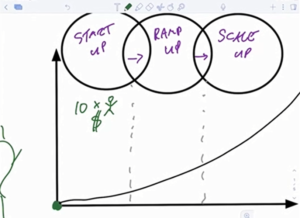
RampUp phase
The goal in the ramp up phase is to focus on moving to the $1 million ARR mark. The reason $1 million is a good benchmark is if you talk to investors about a Series A round, most of them will tell you that they can only talk about Series A once you get to $1 million ARR .
It is not as if they are totally focused on the cash, they just want to prove the viability of your company especially when you are in the early stages, they also know that for you to get to $1 million in ARR you need to have some form of repeatability.
The three challenges you need to overcome in the ramp up phase are:
a) Repeatability in how you generate leads:
How do you fill the funnel? What are your systems for lead generation?
It could be outbound email systems, using LinkedIn, running webinars, going to events or hosting virtual events and more
b) Repeatability in your sales pipeline:
Once a deal is qualified, the steps you need to bring your buyers from interested to paying should be clearly defined.
c) Repeatability around your paying customers:
You should start to see repeatability around your pricing structure, you should see repeatability in how you are onboarding and implementing, you should also see repeatability in how you are retaining customers and reselling to them down the road.
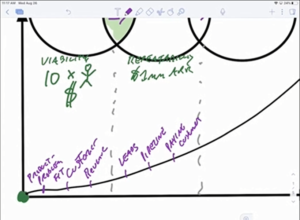
Once you have gone through the ramp up phase then you can transition to the scale up phase.
ScaleUp phase
In the scale up phase, you actually elevate yourself in your company because in the startup and ramp up phase you are probably still doing a lot of the selling as the founder.
When you are in the startup phase, you are the salesperson. In the ramp up phase, you are probably more like an account executive, you might hire a SDR to help you with lead gen once you know how to acquire and get leads. You might hire somebody on customer success to help you implement and support customer but you are still probably doing the main core communication with your customers in order to get them converted.
It is important to know your metrics, hire a team and know how to manage the team in the scale up phase because you are stepping out of the day to day selling and looking at the company as a system.
You need to know what the metrics are and what you should pay attention to. You need to find people that will run the systems you built in the ramp up phase and you need to know who to hire, when to hire, when to fire, when to move people around the organization and how to manage the people you hire.
The scale up phase is the race to the $10 million ARR mark and beyond.
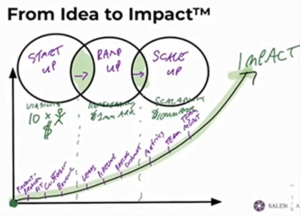
If you try to skip steps and go from startup to scale up without getting systems in place then you are going to fail.
If you are just starting out don’t worry about hiring salespeople, don’t worry about getting repeatable lead gen, all you want to do is find those first customers, get problem products fit, get some money in the door and prove viability of your company before you start worrying about other things.
The Nine Sales Accelerators
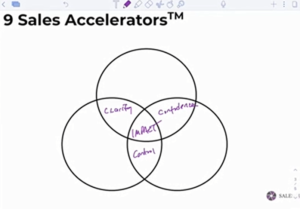
The focus of the sales accelerator is for your product to make an impact in the marketplace. To achieve this, you need to have clarity, some control and confidence in your sales process. You need clarity on who you are targeting and why you are targeting the problem you solve. You need control so that when you engage in conversations, you can help your customers along the buying process.
You want to have the confidence to know that you can solve their problem, charge the price you deserve to charge and your customer should have the confidence to know that if they give you their money, they will get their desired outcome.
From a tactical standpoint you need to have the following:
a) Prospecting plan of action:
This refers to a way of finding your future customers, teaching them about your product and bringing them into your sales funnel.
b) Pipeline pull through:
Once you have a sales opportunity in your sales pipeline you can pull it through the pipeline and go from interested and qualified through the third phase.
c) Paying customer:
The third phase is the paying customer
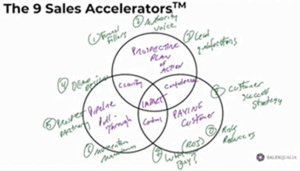
The nine sales accelerators are core systems that if you build and implement upon will accelerate your sales process and growth. They are outlined below:
1) Funnel fillers:
You need to find a way of filling the funnel every day of the week. This could be through having a target list and doing an effective outbound email campaign. It could be through LinkedIn, running webinars, it could be via podcast.
2) Authority voice:
You need to establish your authority voice. You ought to know about the problem you are solving more than your customers. You need to educate your customers and introduce them to the new way of doing things.
3) Lead qualification:
This accelerates your sales because it helps you to make sure you are only spending time with those companies and prospects that are actually in a position to purchase.
By adding this step, you’re actually going to accelerate your sales process even if that means telling some people that they don’t get a demo, because maybe they are the wrong person or the wrong kind of type of company or the timing isn’t right. You have to be comfortable qualifying people out just as much you need to want people to be qualified in.
4) Demo design:
How are you structuring your demo to show how your product solves problems instead of showing them why your buttons are blue and not red. If you do your demo the wrong way, you are going to slow the process down.
You need to find a way to get the stakeholders involved, understand their needs and show them how you are solving their problems.
The demo is a catalyst to the rest of your sales process. And documentation format is equally important in today’s digital age. Consider using a truly impactful pitch deck creator.
5) Prospect Partnering:
Coming out of the product demo, people will have various questions. How does this work? Does it integrate with Hubspot? How secure is your platform? How many seats do we need?
You are going to need some help from your prospect in order to get those questions answered.
Coming out of the demo, you need to have a system to work with your prospects to move this through.
6) Momentum maintainers:
In sales there are usually various reasons why things are slowed down. There have been big external shocks like coronavirus and macroeconomic slowdown. There are also micro reasons which slow peoples lives down such as working from home, going on maternity or paternity leave, children going back to school and so on.
It is your job in sales to make sure that you are maintaining momentum. It is necessary to keep the deal moving despite all the reasons for slowdown. You need to have a set of system that helps keep deals moving because it will accelerate your sales.
For the final three steps, after you have filled the funnel with qualified leads and pulled them through your pipeline, you need to get them to quickly take a decision and decide to work with you. The final three steps of the sales accelerator processor are:
7) Why buy?
How do prove that your product provides a solid return on investment. If you are hearing from people that it is a cool platform but it is just too expensive for us, what they are telling you is that your product is a cost not an investment.
8) Risk reducers:
Enterprise customers who are going to commit a significant cash outlay, time and money on your product see you as a startup and an early stage company. How are they going to believe that your product is going to solve their problem?
By risk reducers you need to have systems like pilot programs or proof of concept or phased rollouts which are ways to reduce the perception of risk so that you can prove success early and make it easy for your customers to proceed to the next step.
It is your job to reduce the risk in the eyes of the customer because even if they don’t say it, they are a little bit concerned that you won’t come through. They don’t want to get criticized, spend political and financial capital on the wrong decision or even risk losing their job so it is necessary to remove that worry by reducing risk.
9) Customer success strategy:
This is part of the sale because it is part of your salespeople job to teach and show customers how you are going to support them. You need to show customers how you are going to support them, how you are going to get them online in the first week.
What are the results they can expect in the first month? What happens at the end of the first quarter?
If you can show them a customer success strategy, it becomes an accelerator in the sales because it reduces the risk, it makes them feel more comfortable with the decision and it becomes a plan of action for them to know they are going to get the results that you want to get for them and they want to get for themselves.
Resources
SalesQualia – Helping B2B startups grow faster
Stop Hustling, Start Scaling by Scott Sambucci
Join the private community of SaaS Founders on Facebook to get access to bi-weekly LIVE Q&A sessions with SaaS experts.
Learn about SaaS Boss Mastermind weekly meetings for SaaS Founders

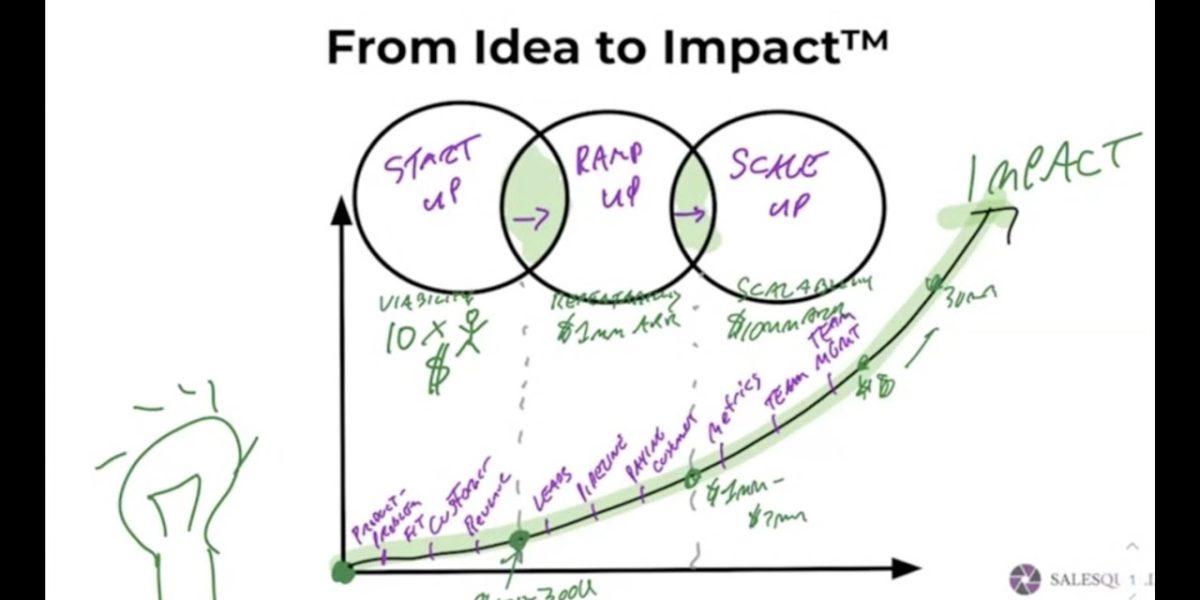
 How to Create a SaaS Dashboard That Drives Growth [Expert’s insights]
How to Create a SaaS Dashboard That Drives Growth [Expert’s insights]